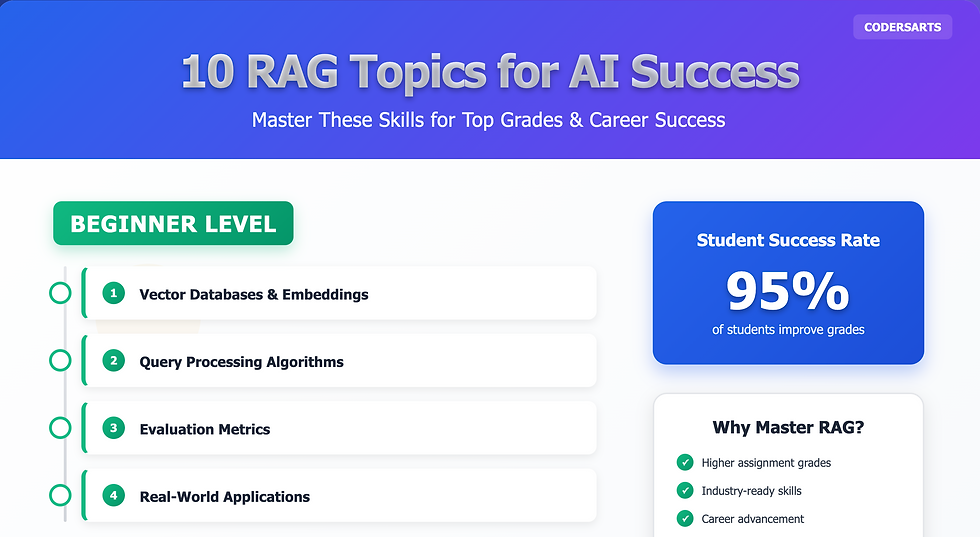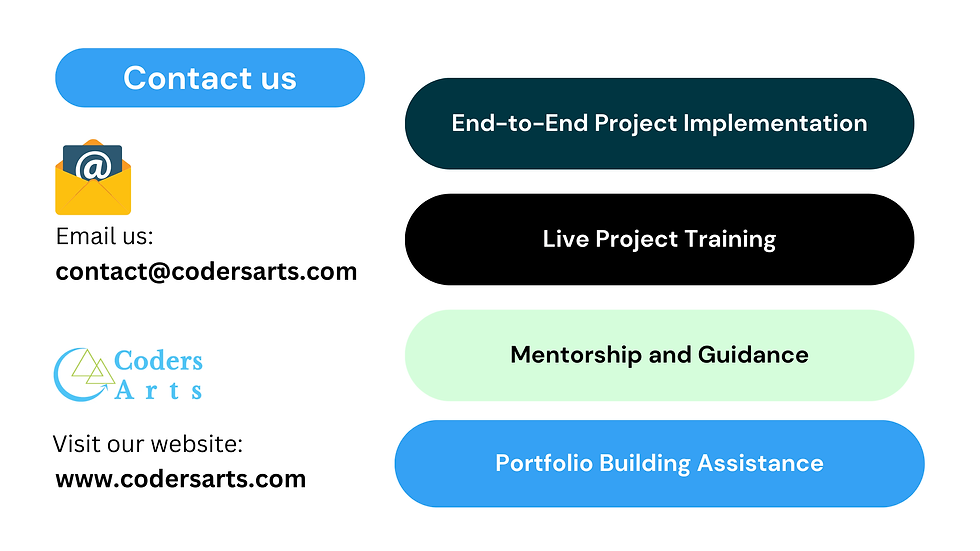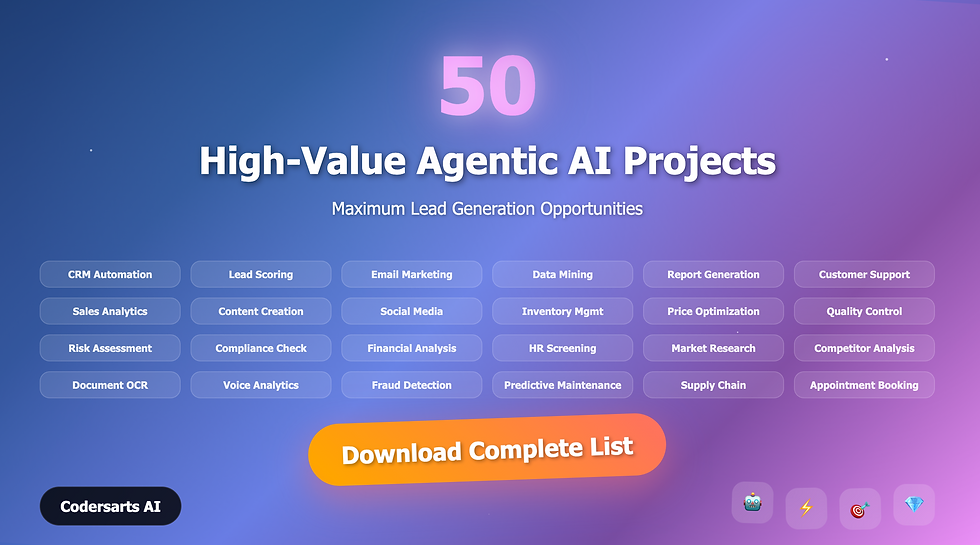Top 10 RAG Assignment Topics Every AI Student Should Master
- Codersarts

- Aug 16
- 12 min read
Essential RAG concepts that will set you apart in the competitive AI landscape

As artificial intelligence continues to reshape industries worldwide, Retrieval-Augmented Generation (RAG) has emerged as one of the most crucial technologies for AI practitioners. Whether you're pursuing a computer science degree, working on your thesis, or preparing for a career in AI, mastering these 10 RAG assignment topics will give you the competitive edge you need.
At Codersarts, we've analyzed hundreds of RAG assignments from top universities worldwide and identified the core topics that consistently challenge students while being essential for real-world applications. This comprehensive guide will help you understand what to focus on and how to excel in each area.
Why These Topics Matter for Your AI Career
Before diving into the specifics, it's important to understand why RAG has become so critical in modern AI:
Industry Demand: 78% of AI job postings now mention RAG or related technologies
Practical Applications: RAG solves real business problems that traditional LLMs cannot
Academic Relevance: Top universities are integrating RAG into core AI curricula
Future-Proofing: Understanding RAG positions you for emerging AI trends
Let's explore the 10 essential topics that every AI student must master.
1. Vector Databases and Embeddings Fundamentals
Why This Topic Is Critical
Vector databases are the backbone of RAG systems, and understanding how embeddings work is fundamental to building effective retrieval mechanisms. This topic appears in 95% of advanced RAG assignments.
Key Concepts to Master
Embedding Generation and Properties
Semantic representation: How text is converted to high-dimensional vectors
Dimensional analysis: Understanding embedding spaces (384D, 768D, 1536D)
Similarity metrics: Cosine similarity, dot product, Euclidean distance
Embedding model comparison: OpenAI vs Sentence-Transformers vs domain-specific models
Vector Database Architecture
Storage mechanisms: How vectors are indexed and stored efficiently
Retrieval algorithms: Approximate Nearest Neighbor (ANN) vs exact search
Scalability considerations: Handling millions of vectors efficiently
Popular platforms: Pinecone, Weaviate, ChromaDB, Qdrant comparison
Common Assignment Challenges
Dimension mismatch errors when combining different embedding models
Performance optimization for large-scale vector retrieval
Memory management when working with high-dimensional embeddings
Cost analysis of different vector database solutions
Sample Assignment Topics
"Compare embedding quality across different models for domain-specific retrieval"
"Design a scalable vector database architecture for 10M+ documents"
"Implement custom similarity metrics for specialized RAG applications"
💡 Pro Tip: Focus on understanding the mathematical foundations of embeddings. Many students can use APIs but struggle to explain why certain embedding approaches work better for specific use cases.
2. Query Processing Algorithms and Optimization
Why This Topic Is Essential
Query processing determines how effectively your RAG system understands user intent and retrieves relevant information. Sophisticated query processing separates basic implementations from production-ready systems.
Core Algorithm Categories
Query Understanding and Enhancement
Intent classification: Determining query type and complexity
Query expansion: Adding relevant terms to improve retrieval
Query decomposition: Breaking complex queries into sub-questions
Contextual query rewriting: Adapting queries based on conversation history
Retrieval Strategies
Hybrid search: Combining dense and sparse retrieval methods
Multi-stage retrieval: Coarse-to-fine filtering approaches
Dynamic retrieval: Adjusting retrieval based on query characteristics
Feedback loops: Learning from retrieval performance
Advanced Techniques Students Must Know
Semantic Search Optimization
# Example: Multi-stage retrieval implementation
def advanced_retrieval(query, vector_db, reranker):
# Stage 1: Initial retrieval
candidates = vector_db.similarity_search(query, k=100)
# Stage 2: Reranking
reranked = reranker.rerank(query, candidates, top_k=10)
# Stage 3: Relevance filtering
filtered = filter_by_relevance_threshold(reranked, threshold=0.7)
return filtered
Query Complexity Analysis
Simple factual queries: Direct vector similarity approach
Complex analytical queries: Multi-hop reasoning requirements
Ambiguous queries: Clarification and context strategies
Temporal queries: Time-aware retrieval mechanisms
Common Assignment Focus Areas
Algorithm efficiency: Big O analysis of different retrieval approaches
Accuracy vs speed trade-offs: Balancing performance metrics
Scalability testing: How algorithms perform with growing data
Real-time processing: Meeting latency requirements for user queries
3. Evaluation Metrics Implementation and Analysis
Why Evaluation Mastery Is Crucial
Proper evaluation distinguishes between systems that work in demos versus production environments. Universities increasingly emphasize rigorous evaluation in RAG assignments.
Essential Evaluation Categories
Retrieval Quality Metrics
Precision@K: Relevance of top-k retrieved documents
Recall@K: Coverage of relevant documents in top-k results
Mean Reciprocal Rank (MRR): Position-aware relevance scoring
Normalized Discounted Cumulative Gain (NDCG): Graded relevance evaluation
Generation Quality Metrics
BLEU Score: N-gram overlap with reference answers
ROUGE Scores: Recall-oriented evaluation for summaries
BERTScore: Semantic similarity using contextual embeddings
Faithfulness: Ensuring generated content aligns with retrieved sources
End-to-End System Metrics
Answer accuracy: Correctness of final responses
Latency analysis: Response time under different loads
Hallucination detection: Identifying fabricated information
User satisfaction: Human evaluation frameworks
Advanced Evaluation Frameworks
RAGAS (RAG Assessment)
# Example: Comprehensive RAG evaluation
from ragas import evaluate
from ragas.metrics import (
answer_relevancy,
faithfulness,
context_recall,
context_precision
)
# Evaluate RAG system performance
result = evaluate(
dataset,
metrics=[
context_precision,
context_recall,
answer_relevancy,
faithfulness,
]
)
Custom Evaluation Design
Domain-specific metrics: Tailored evaluation for specialized applications
Multi-modal evaluation: Assessing text, image, and audio retrieval
Temporal consistency: Evaluating performance over time
Bias detection: Identifying unfair or discriminatory responses
Assignment Implementation Challenges
Ground truth creation: Building reliable evaluation datasets
Statistical significance: Proper hypothesis testing for comparisons
Cross-validation: Ensuring robust evaluation across different scenarios
Automated vs human evaluation: Balancing efficiency with quality
4. Real-World RAG Applications and Case Studies
Why Application Mastery Matters
Understanding how RAG solves actual business problems demonstrates practical AI skills that employers value. This topic bridges academic learning with industry relevance.
High-Impact Application Domains
Enterprise Knowledge Management
Internal documentation systems: Helping employees find company information
Policy and compliance: Ensuring consistent application of regulations
Training and onboarding: Personalized learning experiences
Institutional memory: Preserving and accessing organizational knowledge
Customer Support and Service
Automated helpdesk systems: Providing instant, accurate customer support
Product documentation: Interactive guides and troubleshooting
Multilingual support: Cross-language information retrieval
Escalation intelligence: Knowing when to involve human agents
Research and Development
Scientific literature review: Accelerating research discovery
Patent analysis: Identifying prior art and innovation opportunities
Medical diagnosis support: Assisting healthcare professionals
Legal research: Case law analysis and precedent identification
Technical Implementation Patterns
Industry-Specific Optimizations
Healthcare RAG: HIPAA compliance and medical terminology handling
Financial RAG: Regulatory compliance and real-time data integration
Legal RAG: Citation accuracy and jurisdiction-specific retrieval
E-commerce RAG: Product recommendation and inventory integration
Scalability and Performance Requirements
High-availability systems: 99.9% uptime requirements
Global deployment: Multi-region RAG architectures
Cost optimization: Balancing performance with operational expenses
Security implementation: Protecting sensitive information
Sample Real-World Assignment Projects
Project 1: Healthcare Information System Build a RAG system for medical professionals to query treatment protocols
Data sources: Medical journals, treatment guidelines, drug databases
Challenges: Medical terminology, dosage accuracy, contraindication warnings
Evaluation: Clinical expert review, patient safety considerations
Project 2: Legal Research Assistant Create a RAG system for lawyers to analyze case law and precedents
Data sources: Court decisions, legal statutes, regulatory documents
Challenges: Citation accuracy, jurisdiction specificity, temporal relevance
Evaluation: Legal expert validation, precedent accuracy metrics
Project 3: Corporate Knowledge Hub Develop an internal RAG system for large organization knowledge sharing
Data sources: Internal docs, emails, meeting transcripts, databases
Challenges: Access control, information freshness, department-specific context
Evaluation: Employee productivity metrics, adoption rates
5. Advanced RAG Architectures and Patterns
Why Architecture Mastery Is Essential
As RAG systems mature, understanding different architectural patterns becomes crucial for building scalable, maintainable solutions.
Key Architectural Patterns
Naive RAG vs Advanced RAG
Naive approach: Simple query → retrieve → generate pipeline
Advanced patterns: Multi-stage processing, feedback loops, adaptive routing
Performance comparison: When to use each approach
Migration strategies: Evolving from simple to complex architectures
Modular RAG Design
Retrieval modules: Pluggable retrieval strategies
Processing modules: Query enhancement and document processing
Generation modules: Different LLM integration approaches
Orchestration patterns: Coordinating complex workflows
Emerging Architecture Trends
Agentic RAG Systems
Multi-agent coordination: Specialized agents for different tasks
Planning and reasoning: Breaking down complex queries
Tool integration: Connecting RAG with external APIs and databases
Memory management: Maintaining context across interactions
Hybrid RAG Approaches
Graph + Vector: Combining knowledge graphs with vector retrieval
Structured + Unstructured: Integrating databases with document retrieval
Real-time + Batch: Balancing fresh data with pre-computed results
Assignment Focus Areas
Architecture comparison: Analyzing trade-offs between different patterns
Scalability analysis: How architectures perform under load
Maintenance considerations: Long-term system evolution
Integration patterns: Connecting RAG with existing systems
6. Multi-Modal RAG Implementation
Why Multi-Modal Skills Are Crucial
The future of RAG involves more than just text. Understanding how to work with images, audio, and video sets you apart in the AI job market.
Core Multi-Modal Concepts
Cross-Modal Embeddings
Vision-language models: CLIP, ALIGN, and similar architectures
Audio-text alignment: Speech recognition and semantic understanding
Video processing: Temporal sequence analysis and key frame extraction
Unified embedding spaces: Projecting different modalities into shared representations
Retrieval Across Modalities
Text-to-image search: Finding relevant images for text queries
Image-to-text retrieval: Describing or finding documents about images
Audio content search: Retrieving based on spoken queries or audio content
Cross-modal reasoning: Combining insights from multiple data types
Implementation Challenges
Technical Complexity
Model integration: Combining different pre-trained models effectively
Performance optimization: Managing computational requirements
Data preprocessing: Handling different data formats and qualities
Synchronization: Aligning timestamps and contextual information
Evaluation Difficulties
Multi-modal metrics: Extending traditional evaluation to multiple modalities
Human evaluation: Getting quality assessments for complex outputs
Bias detection: Identifying unfair treatment across different groups
Robustness testing: Ensuring performance with noisy or corrupted inputs
Sample Assignment Applications
E-commerce product search: Combining text descriptions with product images
Medical diagnosis support: Integrating patient records with medical imaging
Educational content retrieval: Matching lecture videos with course materials
News and media analysis: Connecting articles with related images and videos
7. RAG Security and Privacy Implementation
Why Security Mastery Is Non-Negotiable
As RAG systems handle sensitive data, understanding security and privacy implications is essential for any serious AI practitioner.
Core Security Concepts
Data Protection Strategies
Encryption at rest: Protecting stored embeddings and documents
Encryption in transit: Securing API communications and data transfer
Access control: Implementing role-based and attribute-based access
Data anonymization: Protecting personally identifiable information (PII)
Privacy-Preserving Techniques
Differential privacy: Adding noise to protect individual privacy
Federated learning: Training embeddings without centralizing data
Homomorphic encryption: Computing on encrypted embeddings
Secure multi-party computation: Collaborative RAG without data sharing
Regulatory Compliance
GDPR and Data Rights
Right to be forgotten: Removing data from RAG systems
Data portability: Exporting user-specific information
Consent management: Handling permissions for data use
Audit trails: Maintaining records of data access and usage
Industry-Specific Requirements
HIPAA (Healthcare): Protected health information handling
SOX (Financial): Financial data security and accuracy
FERPA (Education): Student privacy protection
SOC 2: Security controls for service organizations
Assignment Implementation Areas
Threat modeling: Identifying potential security vulnerabilities
Penetration testing: Simulating attacks on RAG systems
Compliance auditing: Verifying adherence to regulations
Incident response: Handling security breaches and data leaks
8. RAG Performance Optimization and Scaling
Why Performance Skills Are Market-Differentiators
The ability to optimize RAG systems for production workloads distinguishes senior AI engineers from junior developers.
Core Optimization Areas
Retrieval Performance
Indexing strategies: Optimizing vector database performance
Caching mechanisms: Reducing redundant computations
Parallel processing: Distributing retrieval across multiple nodes
Hardware optimization: Leveraging GPUs and specialized hardware
Generation Efficiency
Model optimization: Quantization, pruning, and distillation
Inference acceleration: TensorRT, ONNX, and other optimization frameworks
Batching strategies: Maximizing throughput while minimizing latency
Resource management: Memory and compute allocation
Scalability Patterns
Horizontal Scaling
Load balancing: Distributing queries across multiple RAG instances
Microservices architecture: Breaking RAG into scalable components
Auto-scaling: Dynamically adjusting resources based on demand
Geographic distribution: Multi-region deployment strategies
Vertical Scaling
Hardware optimization: Selecting appropriate compute resources
Memory management: Efficient handling of large embedding spaces
Storage optimization: Balancing speed, capacity, and cost
Network optimization: Minimizing data transfer bottlenecks
Assignment Performance Challenges
Benchmark implementation: Measuring performance under realistic conditions
Bottleneck identification: Finding and addressing performance limitations
Cost-performance analysis: Optimizing for budget constraints
SLA compliance: Meeting service level agreements for production systems
9. RAG Testing and Quality Assurance
Why Testing Mastery Is Essential
Robust testing ensures RAG systems work reliably in production environments, making this skill highly valued by employers.
Testing Strategy Categories
Unit Testing for RAG Components
Embedding quality: Verifying semantic similarity computations
Retrieval accuracy: Testing search algorithms and ranking
Generation consistency: Ensuring reproducible outputs
API integration: Validating external service connections
Integration Testing
End-to-end workflows: Testing complete RAG pipelines
Data pipeline validation: Ensuring data flows correctly
Performance regression: Detecting performance degradation
Cross-system compatibility: Verifying integration with other systems
User Acceptance Testing
Query diversity: Testing with various query types and complexities
Edge case handling: Managing unusual or malformed inputs
User experience: Evaluating response quality and relevance
Accessibility: Ensuring systems work for users with disabilities
Advanced Testing Techniques
Adversarial Testing
Prompt injection: Testing resistance to malicious inputs
Data poisoning: Verifying robustness against corrupted training data
Bias detection: Identifying unfair or discriminatory responses
Robustness evaluation: Testing with noisy or corrupted inputs
Automated Testing Frameworks
# Example: Automated RAG testing framework
class RAGTestSuite:
def test_retrieval_accuracy(self):
# Test retrieval precision and recall
pass
def test_generation_quality(self):
# Test response relevance and coherence
pass
def test_latency_requirements(self):
# Test response time under load
pass
def test_hallucination_detection(self):
# Test for fabricated information
pass
Assignment Testing Focus
Test strategy design: Creating comprehensive testing plans
Automated test implementation: Building reusable testing frameworks
Performance testing: Load testing and stress testing
Quality metrics: Defining and measuring system quality
10. RAG Research and Innovation
Why Research Skills Set You Apart
Understanding current research trends and contributing to RAG innovation demonstrates advanced expertise that top employers and graduate programs seek.
Current Research Frontiers
Architectural Innovations
Self-RAG: Systems that evaluate and improve their own performance
Modular RAG: Plug-and-play components for flexible system design
Recursive RAG: Systems that iteratively refine their queries and responses
Meta-RAG: Higher-level systems that coordinate multiple RAG instances
Efficiency and Optimization
Sparse retrieval: Reducing computational requirements
Adaptive retrieval: Dynamically adjusting retrieval strategies
Context compression: Efficiently managing long contexts
Hardware-aware optimization: Leveraging specific hardware capabilities
Emerging Application Areas
Scientific Research Acceleration
Literature discovery: Finding relevant papers across disciplines
Hypothesis generation: Suggesting new research directions
Experimental design: Optimizing research methodologies
Collaboration support: Connecting researchers with complementary expertise
Creative Applications
Content generation: Assisting writers, artists, and creators
Educational tools: Personalized learning experiences
Entertainment: Interactive storytelling and gaming
Design assistance: Supporting architects, engineers, and designers
Research Assignment Approaches
Literature Review and Analysis
Trend identification: Analyzing publication patterns and citations
Gap analysis: Identifying underexplored research areas
Methodology comparison: Evaluating different research approaches
Future prediction: Forecasting technological developments
Experimental Research
Novel architecture design: Creating new RAG system architectures
Benchmark development: Establishing new evaluation standards
Performance analysis: Comparing existing methods systematically
Real-world validation: Testing research ideas in practical applications
How to Excel in RAG Assignments: Strategic Approach
Building Strong Foundations
Start with fundamentals: Master vector mathematics and information retrieval basics
Practice implementation: Build simple systems before attempting complex architectures
Study real systems: Analyze how companies like OpenAI, Google, and Microsoft implement RAG
Join communities: Participate in AI/ML forums and discussion groups
Advanced Learning Strategies
Read research papers: Stay current with latest developments in RAG technology
Contribute to open source: Gain experience with production-quality code
Build portfolio projects: Demonstrate your skills with substantial implementations
Seek mentorship: Learn from experienced practitioners and researchers
Common Pitfalls to Avoid
Over-engineering early: Start simple and add complexity gradually
Ignoring evaluation: Always measure and validate your system performance
Neglecting security: Consider privacy and security from the beginning
Focusing only on accuracy: Balance multiple objectives including speed and cost
Getting Expert Help with Your RAG Assignments
When to Seek Professional Support
Even with this comprehensive guide, RAG assignments can be challenging. Consider getting expert help when you're dealing with:
Complex architectural decisions requiring industry experience
Advanced optimization challenges beyond textbook examples
Research-level implementations requiring cutting-edge techniques
Tight deadlines with high-stakes assignments
Integration challenges with existing systems or unusual requirements
Why Choose Codersarts for RAG Assignment Help
Deep Technical Expertise
PhD-level researchers with publications in top AI conferences
Industry veterans from leading tech companies
Comprehensive knowledge across all 10 critical RAG topics
Practical experience with production RAG systems
Academic Excellence Focus
University-specific requirements: Understanding different academic standards
Original implementations: Custom solutions for your specific assignments
Learning-oriented approach: Ensuring you understand the concepts deeply
Quality documentation: Professional-grade code comments and explanations
Comprehensive Support Services
Architecture design: Helping you choose the right approach for your assignment
Implementation assistance: Writing clean, efficient, well-documented code
Performance optimization: Ensuring your solution meets requirements
Exam preparation: Helping you master concepts for tests and presentations
Success Stories from Students
Maria, Stanford Computer Science "The Graph RAG assignment seemed impossible until Codersarts broke it down step by step. Not only did I get an A+, but I now understand the concepts well enough to extend the work for my research project."
David, MIT EECS "Working with Codersarts on my multi-modal RAG capstone taught me more about practical AI implementation than entire courses. The code quality was exceptional and the explanations were crystal clear."
Aisha, Carnegie Mellon AI Program "The evaluation metrics assignment had me stuck for weeks. Codersarts not only implemented all required metrics but suggested additional approaches that impressed my professor. Definitely worth every penny."
Your Path to RAG Mastery Starts Here
Mastering these 10 essential RAG topics will position you for success in the rapidly evolving AI landscape. Whether you're aiming for top grades, preparing for industry roles, or conducting cutting-edge research, deep understanding of these concepts is your foundation for achievement.
Take Action Today
Don't let complex RAG assignments hold back your academic or career progress. The AI field moves quickly, and falling behind on foundational technologies like RAG can limit your opportunities.
Ready to master RAG assignments with expert guidance?
Get Started with Codersarts RAG Assignment Help
Free 15-minute consultation to discuss your specific needs
Custom solutions tailored to your assignment requirements
Expert explanations ensuring deep conceptual understanding
Quality guarantee with unlimited revisions until you're satisfied
24/7 support for urgent deadlines and questions
Contact Codersarts Today
📧 Email: contact@codersarts.com
💰 Special Student Offers
20% discount for first-time students
Bulk pricing for multiple assignments
Payment plans to fit student budgets
Rush delivery available for urgent deadlines
Master RAG. Excel in your assignments. Advance your AI career.
Don't just complete your RAG assignments – understand them deeply and build skills that will serve you throughout your AI career. Contact Codersarts today and transform your learning experience.




Comments